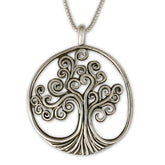The True Meaning of Heart
When we consider the notion of 'heart' this Valentine’s Day, it is easy, in our world where commodity is valued over humanity, to be too small in our hearts—falling into the illusion that our entire life is cast like a shadow against a cave wall. Heart has become a pump for which we need to take daily doses of (some cholesterol drug); its rhythm, our very beat, reduced to jagged lines on a computer screen. Blood and its circular venal passage, becomes just a mechanical process.
Repairing the heart connotes anesthetia and surgeon’s scalpel. Yet, the great twelfth century mystic Iben Arabi believed that the power of the heart was something entirely different—what he called himma. Himma is “the act of meditating, conceiving, imagining, projecting, ardently desiring—in other words, of having (something) present…. which is vital force, soul, heart, intention, thought, desire” (Corbin 222).
(Pictured left: Our 14K Gold over Silver Heart Pendant)
Arabi liberates us from the deadening notion that all that exists is the wonton chaos of irrational dreams. In the heart, with himma, we can begin to extract ourselves from the illusion that the heart’s desire is subjective, merely personal. No, we do not have the heart of a tiny creature living a life of storms in tea cups. Instead, the heart’s longing, the sacred images, are imaginably real rather than subjectively real.
Never betray the mystery message from your heart. Images have numinousity and luminosity. They express our greatest power: our creative imagination that connects our heart with the beat of the universe, enabling us to have the passion to do the good work that life demands—work on ourselves through which we become fully human, and work in the world—both of which are necessary to manifest the Kingdom.
Through this divine power of the heart, we can create something outside of ourselves worthy of the gift of breath. Naturally, the mind may be impatient with the way of the heart. The mind believes it rules; it confuses the notion of rationality with the ecstasy of openings into spaciousness in the heart that come from grace and initiation, all of which are beyond our control.
The heart has its own gates through which one must pass in order to reside in its infinite sea. One wants to experience himma, but finds instead that the need is for purification. The path of the heart requires a diving into transgressions, a breaking down of walls that were constructed to obscure protect oneself, when one’s heart was weak, from the true tragic nature of one’s humanity.
At certain stages, to know one’s heart, one must face the victim and apologize. One can find oneself lying low to the Earth and listening, perhaps to its secret heart beat in order to find, once again, the natural rhythm of one’s own heart. The process has its own time. A moment in the fury of the heart can stretch before and seem like infinity, or it can pass illusively as an image from a dream upon waking. It is easy to want to bypass the dark nights for the Apollonian delights of intellectual conversation accompanied by harp music.
It is also common for some to cut through the process through drugs, just to survive to live another day. Yet, in trying to control the heart we shortchange the heart and our own journey—which can, if traveled well, enlarge us like the widening circles of a hawk. We move through life but life also moves through us. We can use the heart to see our own individual story as part of a greater story. We do not own the images: they are numinous, archetypal and have existed in myth, lore and dreams for tens of thousands of years.
James Hillman pointed out in one of his books that the gods are wounded; therefore, the wounds are divine. A pure heart flows out like a waterfall. It can feel like having an ocean inside of you. Or it can feel like fire. Consuming, enraged, the heart of anger or the heart of love.
The minstrels of today, our pop culture, sing of the ardent heart longing for the beloved. The favorite theme of mystics is pathos for The Beloved—separation being as sweet as unity—on the journey home. Sex In The City or the Chants of Benedictine monks: life is a tavern and you get to choose your wine.
We also have the Heart of the Lion. Regal, radiant, magnanimous, it shines light on all things, like a sun; and does not think, but believes (Hillman 6). It roars because it knows what it is. I am that I am. This is the heart of courage, which to me is the most important quality of the heart, particularly in a committed relationship. Marriage is a kind of alchemical flask, supported by community and commitment, through which the transformation of the heart can take place— but only if one has the courage to go to places that one most deeply fears.
Finally, there is the heart of beauty. Many years ago, a mentor suggested I contemplate a flower to bring its beauty into my heart. This was a time in my life close to my embattled teenage years, when my heart was closed down. Over time, I began to notice my how my heart became more sensitive and awake to beauty in the world. Seeing the beauty through my heart helped me to heal, and transformed how I envisioned the soul of the world.
So I offer to you these humble words from my limited experience. As you celebrate love on Valentine’s Day with romantic dalliance, candles, perhaps crab cakes and a fine Sauvignon Blanc from New Zealand (and hopefully a new piece of our jewelry), consider the deeper mystery of the heart, and movement of all things. Love is youthful and eternal.
We can celebrate that. Cupid never grows up—that love is the glue that holds the universe together, and the heart is its organ of perception. Honor the divinity of your own journey, which is part of a greater journey in the web of life through which we are all connected. And may your heart be blessed with peaceful coexistence with all that is.
References: Henry Corbin, Creative Imagination in the Sufism of Ibn Arabi, Bollinger Series, Princeton University Press, Princetone, NJ, 1969 James Hillman, The Thought of the Heart, Eranos Lectures, Spring Publications, Dallas, Texas, 1981.







